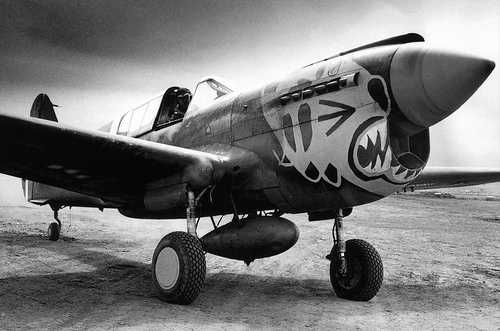This Fine Art Print by Craig Tinder depicts General Chennault's son, Col. John 'Jack' Chennault protecting the Aleutian Islands from Japanese invasion.
Details about the RELIC:
This P-40E Warhawk air intake fragment was discovered near Murmansk, Russia, along the western shoreline of Kola Bay, approximately 40 kilometers from the city. The fragment, along with several other cockpit components, originated from a P-40E Warhawk, an aircraft delivered to the Soviet Union under the Lend-Lease Act during World War II. This international agreement between the United States and its allies provided critical support in the form of war materials, including aircraft, to help in the fight against the Axis powers.
P-40E Warhawk Air Intake fragment
During the war, many P-40s were flown to Alaska and then ferried across the Bering Strait into Soviet territory, eventually reaching the northern regions of Russia. The rugged P-40, known for its resilience and adaptability, became a key component of Soviet air defense. These aircraft were used to defend strategic locations, including the port city of Murmansk, which was a vital hub for Lend-Lease shipments. The harsh conditions of the Russian landscape and the unforgiving climate took a toll on both the pilots and the planes, leading to the loss of many aircraft in the remote wilderness.
The Lend-Lease program provided more than 2,400 P-40s to the Soviet Union, helping to reinforce their air forces in the face of relentless German attacks.
The Story Behind the Print:
During World War II, the 343rd Pursuit Group played a critical role in defending Alaska's Aleutian Islands from the threat of Japanese invasion. From mid-1942 to the fall of 1943, the group, equipped with P-40 Warhawks, safeguarded the U.S. mainland’s northern frontier. The harsh, unpredictable weather and treacherous terrain of the Aleutians made the mission challenging, but the pilots of the 343rd were more than capable. Their P-40s, painted in a modified "shark-mouth" paint scheme as a nod to the iconic Flying Tigers, became symbols of resilience and determination in this remote theater of war.
 P-40E Warhawk - 343rd Pursuit Squadron
P-40E Warhawk - 343rd Pursuit Squadron
The 343rd's commander, Col. John "Jack" Chennault, carried with him the tactical wisdom passed down from his father, General Claire Lee Chennault. Jack applied many of the same strategies that his father had developed during his leadership of the American Volunteer Group (AVG) in China. These tactics, which involved diving from high altitudes to attack enemy aircraft and quickly disengaging, proved highly effective in the unique challenges of aerial combat in the Aleutians. Under Jack's leadership, the 343rd successfully repelled Japanese attempts to threaten American soil.
General Claire Lee Chennault had achieved legendary status as the leader of the Flying Tigers, training his pilots to exploit the strengths of the P-40 in their battles against Japanese forces in China. He emphasized using the Warhawk’s speed in dives and its heavy armament to strike quickly and powerfully, a tactic designed to overcome the Japanese aircraft's superior maneuverability. These lessons proved invaluable not only in China but also in the defense of the Aleutians, where Jack Chennault’s squadron applied his father's methods with precision.
The connection between the Chennaults and the P-40 Warhawk is a story of innovation, courage, and tactical brilliance. Claire Chennault’s strategies in the skies over China not only saved lives and boosted morale during the early stages of the war but also influenced his son’s successful defense of Alaska. The 343rd Pursuit Group’s mission in the Aleutians, using these proven tactics, secured an important victory in protecting the U.S. from a northern invasion, marking another chapter in the enduring legacy of the P-40 Warhawk.
Learn more about Exploring the Military Contributions of Claire and John Chennault in Aviation and the Air Force for Father and Son Legacy? Click Here
To purchase or see similar items, visit here.
Commissioned by Museums, Treasured by Collectors






Share:
Letters from Home, the story behind "Hurry Home Honey"
Shark Mouthed Warrior , the story behind "Old Exterminator"